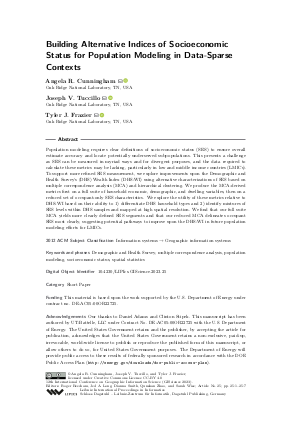@InProceedings{cunningham_et_al:LIPIcs.GIScience.2023.25,
author = {Cunningham, Angela R. and Tuccillo, Joseph V. and Frazier, Tyler J.},
title = {{Building Alternative Indices of Socioeconomic Status for Population Modeling in Data-Sparse Contexts}},
booktitle = {12th International Conference on Geographic Information Science (GIScience 2023)},
pages = {25:1--25:7},
series = {Leibniz International Proceedings in Informatics (LIPIcs)},
ISBN = {978-3-95977-288-4},
ISSN = {1868-8969},
year = {2023},
volume = {277},
editor = {Beecham, Roger and Long, Jed A. and Smith, Dianna and Zhao, Qunshan and Wise, Sarah},
publisher = {Schloss Dagstuhl -- Leibniz-Zentrum f{\"u}r Informatik},
address = {Dagstuhl, Germany},
URL = {https://drops.dagstuhl.de/entities/document/10.4230/LIPIcs.GIScience.2023.25},
URN = {urn:nbn:de:0030-drops-189204},
doi = {10.4230/LIPIcs.GIScience.2023.25},
annote = {Keywords: Demographic and Health Survey, multiple correspondence analysis, population modeling, socioeconomic status, spatial statistics}
}

 Creative Commons Attribution 4.0 International license
Creative Commons Attribution 4.0 International license



